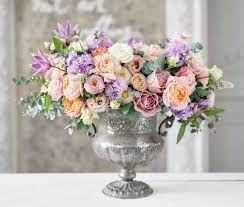
8 Easy Patterns for Arrangements with Flowers
It may take a while to adjust to working with silks instead of real flowers since they have different properties and constraints. Despite their similarity in function, the creation of artificial flowers is a distinct artistic endeavor. The line, focus, and filler method works well for creating Seremban florist arrangements with dried flowers and fake flowers.
Arranged Horizontally
- First, in a moderately shallow vase, glue including using anchoring pins to secure foam, and then place bouquets of line blossoms to form the outline of your design.
- Place focal blooms in the center, and arrange them so that their stems drape loosely over the edge of the vase on both sides, extending toward the line material. Don’t forget the filler flowers!
- Third, use filler flowers and greenery to accentuate the space surrounding the primary point.
Setups in the Vertical
- Install foam inside a vase by wedging it in or securing it with hot glue. The biggest flowers or foliage should have their stems trimmed to a height of three to four times the length of the vase.
- Second, arrange the vase’s focus flowers vertically inside the vase’s circumference.
- Add some filler flowers when necessary.
Triangular flower Arrangements
- Protect floral foam. Use the flowers and/or leaves with the thinnest lines to calculate the vertical and horizontal dimensions. Ensure that the height exceeds the width.
- Second, to create a sense of balance and weight, place the arrangement’s biggest focal blooms in the middle, somewhat lower than the rest of the flowers.
- The third step is to fill up the empty spaces with filler flowers and greenery while still maintaining the triangle design.
Arranging in Crescent Shapes
- Put the foam into the container and make sure it’s secure. You may make crescent flowers or leaves by calculating the length of the crescent and inserting a curved line to fit the crescent shape. To prevent it from tipping over in the container, tilt it.
- To create harmony, stability, and depth, place the focus flowers at the bottom of the bowl.
- Third, surround the main blooms with a border of supplementary flowers and foliage of a lesser scale. Fill in the gaps with delicate, drooping flowers.
Dispositions in oval forms
- To begin, make sure the floral foam is safe. Use line flowers to establish the overall height, and then fill in the perimeter of an oval with lighter blooms and foliage.
- Secondly, make sure the biggest, most robust, or most vibrant blooms are at the center of attention.
- Put some filler flowers in between the bigger blooms and the larger foliage.
Separately Placed Objects
- Pour enough foam into a shallow container so that it reaches within an inch of the top. Use floral tape, floral clay, or hot glue to secure the foam in place. Use the outlines of the flowers and leaves to establish the design’s contours.
- Place the main flowers and foliage in the vase, rotating it as you go to ensure that all of the edges are equal, and then fill in the surrounding space.
- Third, fill in the design with some filler flowers to tie everything together.
These methods, taken from several sources including books, periodicals, online articles, and clippings devoted to floral fundamentals, have been combined. White On White Johor Bahru florist is the place to go to get these kinds of flower arrangements.
